Above: Protests continue for a separate Gorkha state
There is more to the latest agitation for statehood than culture and language. Is there also the need to divert attention from the misappropriation of central funds by those spearheading the protests?
~By Sujit Bhar
It would be an understatement to say that the hills of West Bengal are on the boil. In complete defiance of the Calcutta High Court’s ruling of June 16 that the indefinite “bandh” in Darjeeling and adjoining hill areas was illegal, the Gorkha Janmukti Morcha (GJM) and its president Bimal Gurung have continued on the warpath to complete chaos.
The GJM’s determination to prolong its agitation was evident when it provided a 12-hour window on June 23 during which all residential school students in Darjeeling were asked to leave town for home. Since agitations began in Darjeeling with the demand for statehood in 1986, this had rarely happened (ex-cept during a 40-day strike called in the 1980s). Darjeeling has some of the best boarding schools in the country and they have mostly been left alone. These institutions are as much a pride of the area as its world-famous tea and its popular hill station status.
These three are also the prime revenue earners, not only of the region, but also of West Bengal. The three are also, almost totally, controlled by people from the plains.
West Bengal Chief Minister Mamata Banerjee’s order that Bengali be made compulsory in schools across the state was the spark that rekindled violent agitations in the hills. But this is certainly not a mere language agitation or just a cultural issue. Even the Nepali population/language theory can scarcely be supported by history.
Gorkhas of India
The community and its identity crisis
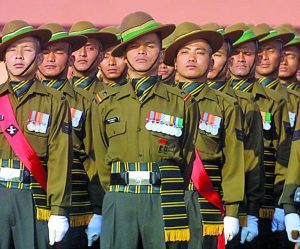 In India, Gorkhas have a very special status. They are Indian Gorkhas. That is their legal status and despite their land of origin being Nepal, they cannot be called Nepalis, though they share the same language. They are Indian as per the Gazette notification of the Government of India on the issue of citizenship of the Gorkhas of India.
In India, Gorkhas have a very special status. They are Indian Gorkhas. That is their legal status and despite their land of origin being Nepal, they cannot be called Nepalis, though they share the same language. They are Indian as per the Gazette notification of the Government of India on the issue of citizenship of the Gorkhas of India.
They do face an identity crisis in India, though, because of two reasons. They are not categorised as indigenous people of India (not of any Scheduled Tribe). And, the Indo-Nepal Treaty of Peace and Friendship (1950) that permits “on a reciprocal basis, the nationals of one country in the territories of the other the same privileges in the matter of residence, ownership of property, participation in trade and commerce, movement and other privileges of a similar nature,” creates an identity crisis. Hence often Indian Gorkhas are mistaken for being Nepali people.
What is significant in this is that in April last year the Modi government started the process that could lead to grant of Scheduled Tribe status to 11 Gorkha communities, mostly living in Sikkim and Bengal. The tribal affairs ministry on April 2, 2016 set up a committee under joint secretary Ashok Pai to examine granting ST status to 11 communities—Bhujel, Gurang, Mangar, Newar, Jogi, Khas, Rai, Sunwar, Thami, Yakhha and Dhimal—living in Sikkim and other Gorkha-dominated states and areas. That was just before West Bengal was going to the assembly polls and the timing was questioned in many state circles.
In Mizoram (as well as Nagaland), where many Nepalis were domiciled for years, they were categorised as “foreigners” in early 1990s. In Meghalaya, the Khasi students and the government together deported about 7,000-10,000 Nepalis in February-March, 1987. How many of them were Gorkhas has not been recorded.
The argument has been: “How can a certain section of people be “foreigners” in one state, while demand to own a full state in another region of the same country?” The term “Gorkha” would make the legal difference.
If one compares the demand for Gorkhaland with, say, the Bodoland agitation, the differences are stark.
The Bodos have been established as indigenous people of the areas located in the extreme north on the north bank of the Brahmaputra river in the state of Assam. Currently, the map of Bodoland includes the Bodoland Territorial Area Districts (BTAD) administered by the Bodoland Territorial Council (BTC) and other parts covering over 25,000 sq km. The territory came into existence under the BTC Accord in February 2003.
After the Gorkha National Liberation Front’s (GNLF) 40-day violent strike in the 1980s, its leader Subhas Ghising achieved limited autonomy. The Darjeeling Gorkha Hill Council got powers to govern the district, but revenue was a state subject, so were law and order and legislative powers.
The Gorkha Janmukti Morcha also demanded Gorkhaland, but got the Gorkha Territorial Administration (GTA), which had no more powers than the GNLF. The GTA still does not have powers of legislation. However, there was a fresh influx of funds from the centre as well as from Kolkata.
HISTORICAL PERSPECTIVE
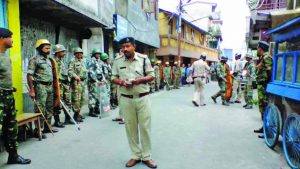
Darjeeling wasn’t a part of Nepal. It was a part of the Sikkim kingdom, hence inhabited mostly by the Lepcha and the Bhutia tribes. In 1790, a Gorkha army from Nepal invaded Sikkim and annexed large tracts of land including Darjeeling, up to the Teesta River near Nepal. However, the British (East India Company soldiers) retaliated and in the Anglo-Gorkha war the Gorkhas were pushed back in 1817. The army left, but a Nepali population stayed back in what originally was Lepcha and Bhutia territory. They were the original Gorkhas of India (see box on Gorkha status).
Post independence Darjeeling was merged with West Bengal as a separate district. Darjeeling town apart, this district included hill towns Kurseong, Kalimpong and the Terai areas of Siliguri. Another mix of ethnicity happened in 1950 when the People’s Liberation Army of China annexed Tibet. Thousands of Tibetan refugees settled across the district. Add to that the fact that the predominant trading community, the backbone of the district, are mostly Marwaris and Bengalis from the plains. Such a mix makes Gurung’s claim look somewhat specious.
Gurung is the principal fomenter of trouble in the area and has created a “Gorkha” movement like his predecessor Subhas Ghising. Three persons have already died in the latest outbreak of protests and a police officer critically injured, while work and business remains at a standstill. Tourists have been forced to leave during the peak tourist season and the losses incurred will be huge.
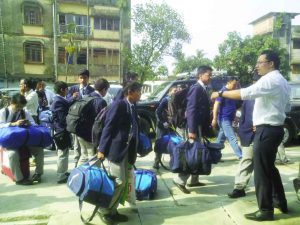
But who is Bimal Gurung? The GJM leader came to the limelight through the television reality show, Indian Idol. No, he did not sing but he helped a winner take the singing world by storm. Gurung was a small-time soldier for Subhas Ghising in the 1980s. He caught public attention after he saw the Kolkata police constable Prashant Tamang, a Nepali also from Darjeeling, qualifying for the last rounds of the Indian Idol song contest in 2007.
Gurung went all out and helped Tamang by asking all Nepali-speaking residents of Darjeeling and adjoining areas to vote via SMS for Tamang. He won the 2008 edition of the show and that literally catapulted Gurung into the limelight.
“It’s not the voice of logic, but the noise of the gun”
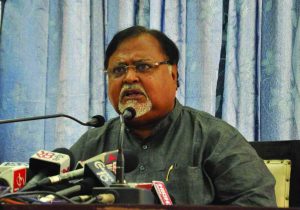 Partha Chatterjee, the Parliamentary Affairs and Education minister of West Bengal, is virtually the No 2 in the administration of Chief Minister Mamata Banerjee. In a telephonic interview with Sujit Bhar, Chatterjee explains the chief minister and the Trinamool Congress’ views on the Gorkhaland agitation in Darjeeling. Excerpts:
Partha Chatterjee, the Parliamentary Affairs and Education minister of West Bengal, is virtually the No 2 in the administration of Chief Minister Mamata Banerjee. In a telephonic interview with Sujit Bhar, Chatterjee explains the chief minister and the Trinamool Congress’ views on the Gorkhaland agitation in Darjeeling. Excerpts:
How much of this Gorkhaland agitation is really about language?
It is certainly not about language. This is a specious argument. Our netri, Mamata Banerjee, had personally explained that Bengali will not be compulsory in the hills, where Nepali is the prevalent language. There is more to the issue than language, and this has to be looked into by law enforcement authorities. It needs a deep probe.
What about the Calcutta High Court’s order…
If despite what the CM has clearly said, the agitation continues, then the very basis of the agitation has no meaning. The court’s judgement that this bandh is completely illegal is a sound one, and one clearly sees a contempt of court issue cropping up. The court has to now take action.
If it is not about language, what in your opinion is the reason for Bimal Gurung’s agitation?
My reading would be—the funds and the huge defalcation that has been going on in the hills. When the GTA received its Rs 2,000 crore five years back, it was quiet for a long time. Now, it is time to explain how the money was spent. Now is the time for audit. That is when Gurung wants to create a diversion to take attention away from the money trail.
Is the BJP behind fomenting trouble in the hills?
The law will find out who is responsible and punish them. As for the TMC, we are concerned about the well-being of the people of the hills. As our leader said, she wants peace to return and normalcy is important for the development of the region. Chaos cannot help development.
But you surely believe there is a political motive.
There surely has been some dirty politics involved. What is ruling in Darjeeling is not the voice of logic, but the noise of the gun. Since the TMC took over after the Left Front’s mismanagement some good sense had returned. But now it is time for an investigation to look into the whys. Mostly, it is about the money. They needed an issue to divert attention. Sadly, they have been aided and abetted by interested parties.
Do these interested parties include the BJP? Does the centre have a hand in trying to destabilise the area to find a route into West Bengal?
I repeat again, whoever is responsible will be found out by the law and punished.
DECADES OF MISMANAGEMENT
To be fair to Mamata, she and her Trinamool Congress (TMC) have tried to make the best of a bad deal handed down, following 34 years of mismanagement by the Left Front governments. Reacting fast to the depleting cash reserves of the tea gardens during the chaotic demonetisation experiment of the Narendra Modi government, she forced the centre’s hand in releasing cash for payment to tea estate labourers. She also undertook a slew of development work.
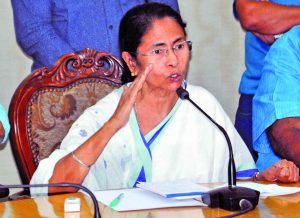
It’s not about culture, it’s not about a language—Mamata has made it clear that the Bengali stricture does not apply to the hills—it’s about politics and money. The very basis of the bandh is to throttle local business, thriving on the two main revenue pillars, the tea industry and tourism, and gain financial billets from the centre that mostly disappear into unspecified pockets.
West Bengal government’s Education Minister Partha Chatterjee, told India Legal: “The Gorkha Territorial Admin-istration (GTA) of the GJM had it fine for five years, and just when it was time to face audit, and account for the Rs 2,000 crore it had received and how they have spent it, they are now trying other methods to divert attention.”
Chatterjee, who is virtually the number two in the Mamata Banerjee administration, was clear in indicating that the money has disappeared without a trace of the development it was intended for. Technically, the Left Front had a similar grouse against Gorkha National Liberation Front chairman Subhas Ghising, who started the hill agitation in the 1980s. The “defalcation” of funds has been mammoth and there has never been any solid contest of this allegation.
In a late development, Gurung and 43 other GJM members resigned from the GTA on Friday (June 23), calling it a “farce”.
Then there is the question of statehood. The constitution gives powers only to parliament to form new states. The identity of states can be altered or even expunged only by the parliament. The constituent assembly had declined a motion in its concluding stages to designate India as a “Federation of States”.
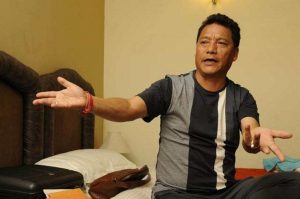
That shifts focus to the government at the centre. In the 2014 general elections, BJP’s SS Ahluwalia won the Darjeeling Lok Sabha seat, taking over from his party’s earlier winner (2009), Jaswant Singh from the same seat. These consecutive wins are spectacular, considering the only other BJP MP in this state is a singer and current Union minister—Babul Supriyo, from Asansol. The BJP votes in the area were from two principal sources: anti-TMC sentiment and the huge trading community from the plains, mostly BJP supporters.
Interestingly, despite Mamata’s running battle with the BJP and the centre, Chatterjee was not too keen in pointing to the BJP’s role in instigating trouble (see interview). Clearly, TMC wants to keep one door open for negotiations.
Mamata, before her departure to the Netherlands for a UN engagement, had called for peace in the hills. At the time of going to press, the army continues to patrol the area even as GJM rallies persist. The situation remains tense. And, trouble could boil over any time.


